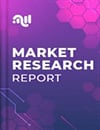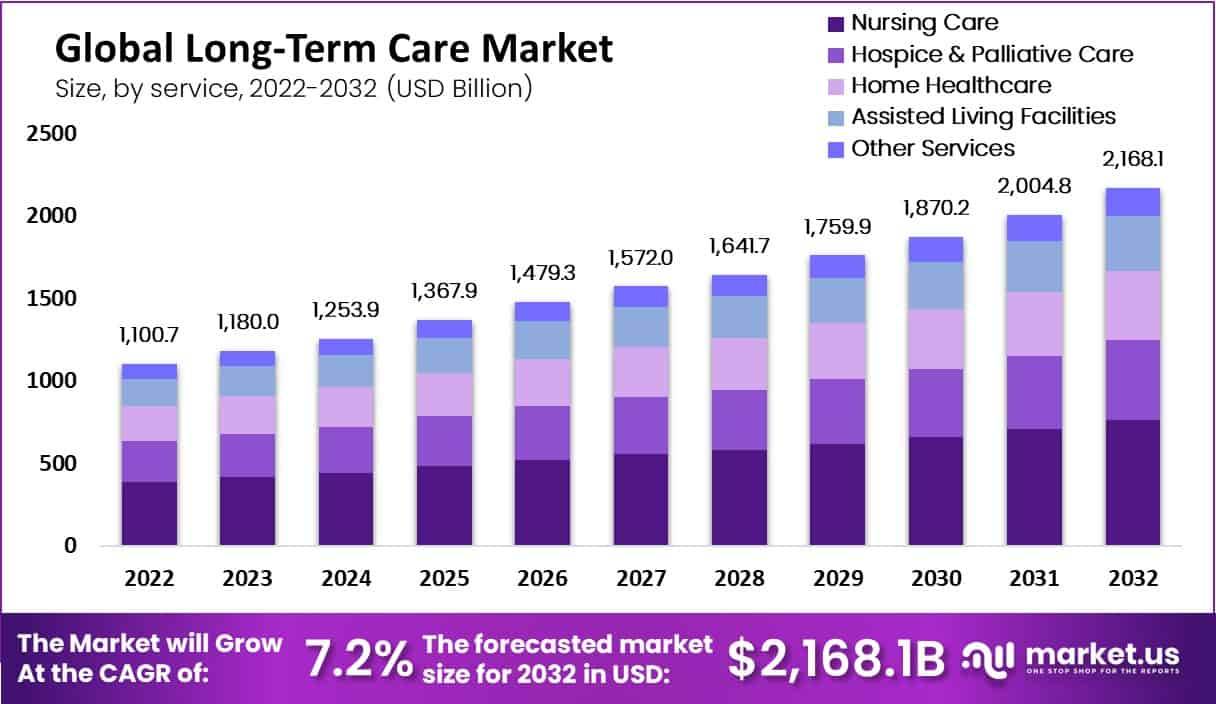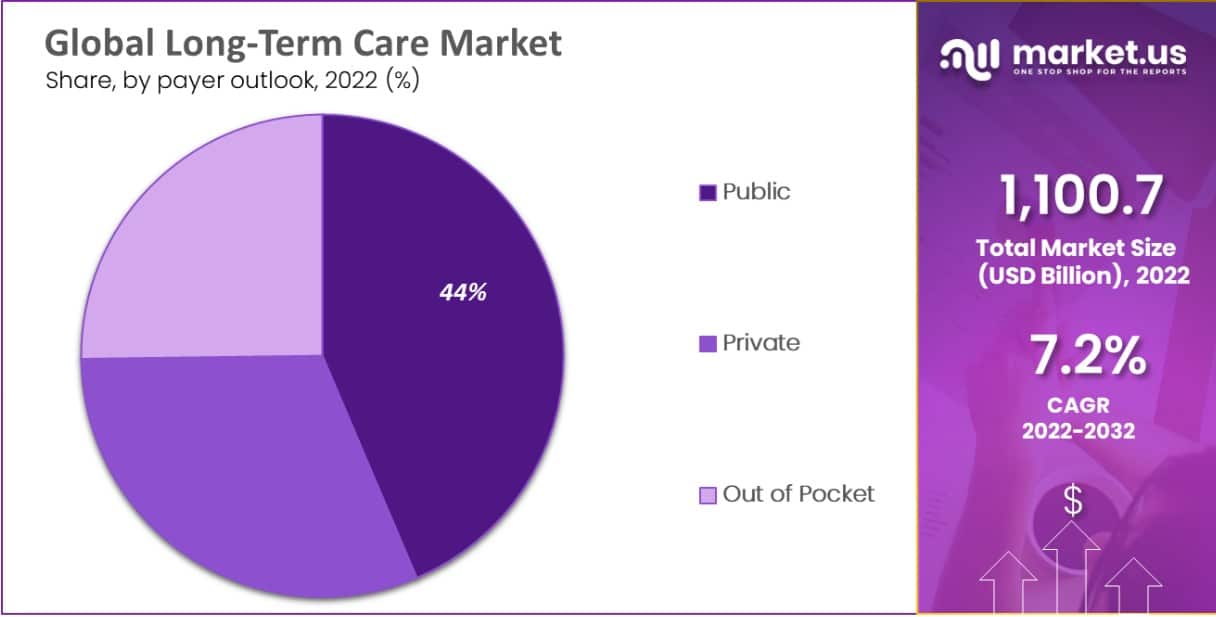Global Long-Term Care (LTC) Market by Service (Home Healthcare, Hospice & Palliative Care, and Other Services), By Payer Outlook (Public, Private, and Out of Pocket), By Region and Companies - Industry Segment Outlook, Market Assessment, Competition Scenario, Trends, and Forecast 2023-2032
- Published date: Oct 2023
- Report ID: 12480
- Number of Pages: 291
- Format:
- keyboard_arrow_up
Quick Navigation
Report Overview
In 2022, the Global Long-Term Care Market accounted for USD 1100.7 Billion and is expected to reach around USD 2168.1 Billion in 2032. Between 2023 and 2032, this market is estimated to register a CAGR of 7.2%.
The long-term care market refers to the wide range of its services and products available to support individuals who are having chronic illnesses, disabilities, and other conditions which require care and support. The market includes a variety of services like nursing homes, home health care, assisted living facilities, and hospice care.

*Actual Numbers Might Vary In The Final Report
The market is driven by many factors which include an aging population, changing attitudes towards aging and healthcare, and advance in medical technology. The LTC market is challenging and complex for consumers to navigate, it is important for individuals and their families to carefully consider their options and choose a provider that can meet their specific preferences and needs.
The increase in the population of older people is a major concern in many countries across the globe. The last baby boomer generation reached the age span of 52-70 years in 2016 which was the largest aged cohort so far. Also, more than 54% of the old population is concentrated only in six countries which include, China, The U.S., Japan, India, Germany, and Russian Federation.
Key Takeaways
- Aging Population: Long-term care services have seen their market dramatically affected by an aging global population, which continues to outlive previous expectations as people age and demand increases for nursing homes and home healthcare services such as these.
- Long-Term Care Settings: Long-term care covers an array of care settings, such as skilled nursing facilities, assisted living communities, in-home care services and adult day care centers – this variety provides individuals with care tailored specifically to their unique needs and preferences.
- Healthcare Cost Management: Long-term care services play a pivotal role in controlling healthcare expenditures for those living with chronic conditions or disabilities, especially by offering alternatives to hospitalization that help keep costs in check. By offering care at home instead, long-term care services may lower healthcare expenses dramatically.
- Quality Care and Patient Safety: Long-term care facilities must ensure high standards for care delivery to ensure patient wellbeing, according to regulatory bodies and healthcare organizations.
- Technology Integration: Telehealth and electronic health records have transformed long-term care, improving care coordination, remote monitoring and data management. These innovations offer real value.
Driving Factors
Aging Population, Changing Demographics and Lifestyles Drives the Market Growth of the Long-Term Care Market
The factors which drive the growth of the long-term care market include, an aging population which is a significant driver of the long-term care market, as people age then they are more likely to experience chronic illnesses and disabilities which require ongoing support and care.
Advances in medical technology have enabled people to live to linger with chronic conditions and disabilities which increased the demand for long-term care services. Changes in demographics and lifestyles led to an increase in the number of people living alone, which has created a greater need for long-term care services.
Rising healthcare costs made it difficult for individuals to afford long-term care services which increased demand for cost-effective alternatives, like home healthcare. Technological innovations like telemedicine and remote monitoring enabled long-term care providers to deliver care more effectively and efficiently which increased the demand for these services. Government policies and regulations also impact the long-term care market by providing funding, regulating the industry, and setting quality standards.
Restraining Factors
Quality Care, Workforce Shortages, and Regulatory Constraints are some restraints for the long-term care market
Long-term care also has some restraints in the global market which affect the growth of the long-term care market. The LTC market heavily relies on skilled healthcare workers which can make it difficult for long-term care providers to deliver quality care.
The cost of long-term care services can high for many individuals and families. Many insurance plans like Medicare and Medicaid have limited coverage for long-term care services which can make it tricky for individuals to access the care they need.
There is still a stigma attached to long-term care it makes difficult for providers to attract and retain their clients. These restraints will be critical for ensuring that individuals have access to the care and support they need as they age or deal with chronic disabilities or illnesses.
Service Analysis
The nursing care type segment is the most lucrative segment in the service type of long-term care market
Based on service, the market for long-term care is segmented into nursing care, hospice & palliative care, nursing care, and assisted living facilities. Among these services, the nursing care segment is the most lucrative in the global long-term care market, with a projected CAGR of 8.5%.
The total revenue share of nursing care services in the long-term care market is 35.2% in 2022, due to its high demand from developing countries. The need for nursing care is growing due to the increasing aging population, and the prevalence of chronic diseases like heart problems, cancer, and Alzheimer’s.
The Hospice & Palliative Care segment is expected to grow faster in the projected period in the long-term care market.
Hospice & palliative care services accounted for the fastest-growing segment in the long-term care market, and its estimated market share is 22.2% in 2022. This is due to the increasing prevalence of chronic diseases and the increasing need for 24 hour-medical attention.
A report published by the world health organization in 2018 says only 14% of peoples which needed palliative care received it among all needy people. Around 40 million people need palliative care each year, of which 78% live in low- and middle-income countries and that’s why they fail to get palliative care treatment.
Payer Outlook Analysis
The Public Payer Outlook segment accounted for the largest revenue share in the long-term care market in 2022.
Based on the payer outlook, the market is segmented into public, private, and out-of-pocket. Among these, the public segment dominates the long-term care market with the largest share of 44% in 2022. Particularly in some countries publicly funded long-term care programs are designed to provide care and support low-income and vulnerable populations which may not be able to afford private care.
In many countries, the public sector provides funds for long-term care in the form of Medicaid in The U.S., Medicare in Canada, and the National Health Service in The UK. This program provides a wide range of long-term care services, which include home health care, assisted living, and nursing home care.

The Private Payer Outlook segment is expected to be the fastest-growing payer outlook segment in the long-term care market.
The private segment is also a crucial part of the long-term care market, especially in countries where healthcare systems are based on a mix of public and private.
Private long-term care providers can offer high-quality care and may provide more flexibility in the service and timing. Private long-term care providers may operate for profit or not for profit and may vary in size from small to multinational corporations.
Key Market Segments
Based on Service
- Home Healthcare
- Hospice & Palliative Care
- Nursing Care
- Assisted Living Facilities
- Other Services
Based on Payer Outlook
- Public
- Private
- Out of Pocket
Growth Opportunity
Aging Population, Private Sector Investments, and Global Demand Creates Opportunities in the long-term care Market
The long-term care industry is also boosting due to the growing demand for an aging population as the population ages there will be increased demand for long-term care services. Technological advancement is improving the quality of care for patients and increasing the efficiency of healthcare providers.
Advancements like remote monitoring, and telehealth will make it easier for patients to receive care from home, reducing the need for long-term care facilities. Private sector investment in the LTC is increasing as many investors are recognizing the potential for growth in the industry and investing in long-term care facilities and services.
The LTC market is all around the world so there is a growing demand for long-term care services around the globe, particularly in Asia and Europe, that is due to aging populations and changing family structures.
Latest Trends
The Aging Population, Fous on Home and Community Based Services, and Technology Innovation are some recent trends in the long-term care market
The need for long-term care services is anticipated to rise drastically as the baby boomer generation ages. In order to fulfill the rising demand, this will put pressure on payers and providers to create new care models and delivery methods.
As opposed to institutional settings like nursing homes, there is increased interest in offering long-term care services in the home and community. This type of care delivery may be more affordable and person-centered.
Long-term care services are being delivered more effectively and efficiently by providers because of new technology like remote monitoring and telehealth. This can assist to enhance access to care, lower costs, and improving outcomes.
Regional Analysis
North America Accounted for the Largest Revenue Share in Long-Term Care Market in 2022.
North America is estimated to be the most lucrative market in the global long-term care market, with the largest market share of 49.27% in 2022. North America has the largest long-term care market in the world because of its aging population, high healthcare spending, and sophisticated healthcare infrastructure.
Public and private long-term care facilities, such as nursing homes, assisted living facilities, and home care organizations, are available in both the United States and Canada.

APAC is expected as Fastest Growing Region in Projected Period in Long-Term Care Market.
Asia Pacific is expected as the fastest-growing region in the long-term care market with a CAGR of 8.18%. Owing to its growing demand for healthcare services and rapidly aging population. South Korea, Australia, and Japan have grown-up countries in the long-term care systems while other countries like India and China are expanding their long-term care infrastructure.
Key Regions
- North America
- o The US
- o Canada
- o Mexico
- Western Europe
- o Germany
- o France
- o The UK
- o Spain
- o Italy
- o Portugal
- o Ireland
- o Austria
- o Switzerland
- o Benelux
- o Nordic
- o Rest of Western Europe
- Eastern Europe
- o Russia
- o Poland
- o The Czech Republic
- o Greece
- o Rest of Eastern Europe
- APAC
- o China
- o Japan
- o South Korea
- o India
- o Australia & New Zealand
- o Indonesia
- o Malaysia
- o Philippines
- o Singapore
- o Thailand
- o Vietnam
- o Rest of APAC
- Latin America
- o Brazil
- o Colombia
- o Chile
- o Argentina
- o Costa Rica
- o Rest of Latin America
- Middle East & Africa
- o Algeria
- o Egypt
- o Israel
- o Kuwait
- o Nigeria
- o Saudi Arabia
- o South Africa
- o Turkey
- o United Arab Emirates
- o Rest of MEA
Key Players Analysis
Emerging key players are focused on exploring various care settings like assisted living facilities, hospice care providers, nursing homes, and home healthcare. The key factors for market growth are the increasing prevalence of chronic diseases, rising healthcare costs, and the aging population. Brookdale Senior Living Inc. is one of the largest players in the market.
Listed below are some of the most prominent Long-Term Care industry players.
Market Key Players:
- Brookdale Senior Living Inc.
- Sunrise Carlisle LP
- Atria Senior Living Group
- Extendicare Inc.
- Capital Senior Living
- Diversicare Healthcare Services Inc.
- Kindred Healthcare Inc.
- Genesis Healthcare Corp.
- Senior Care Centers of America
- Home Instead Senior Care Inc.
- Amedisys Inc.
- Other Key Players
Recent Developments
- In November 2021, Brookdale Senior Living Inc., one of the largest operators of senior living communities in the U.S., announced that it had sold its home health and hospice business to HCA Healthcare.
- In December 2021, Amedisys Inc., a leading home healthcare and hospice services provider announced that it had acquired Contessa Health, a specializes in providing hospital-level care in patient’s homes.
Report Scope
Report Features Description Market Value (2022) USD 1100.7 Bn Forecast Revenue (2032) USD 2168.1 Bn CAGR (2023-2032) 7.2% Base Year for Estimation 2022 Historic Period 2016-2021 Forecast Period 2023-2032 Report Coverage Revenue Forecast, Market Dynamics, COVID-19 Impact, Competitive Landscape, Recent Developments Segments Covered By Service (Home Healthcare, Hospice & Palliative Care, Nursing Care, Assisted Living Facilities, Other Services), By Payer Outlook (Public, Private, Out of Pocket) Regional Analysis North America – The US, Canada, & Mexico; Western Europe – Germany, France, The UK, Spain, Italy, Portugal, Ireland, Austria, Switzerland, Benelux, Nordic, & Rest of Western Europe; Eastern Europe – Russia, Poland, The Czech Republic, Greece, & Rest of Eastern Europe; APAC – China, Japan, South Korea, India, Australia & New Zealand, Indonesia, Malaysia, Philippines, Singapore, Thailand, Vietnam, & Rest of APAC; Latin America – Brazil, Colombia, Chile, Argentina, Costa Rica, & Rest of Latin America; Middle East & Africa – Algeria, Egypt, Israel, Kuwait, Nigeria, Saudi Arabia, South Africa, Turkey, United Arab Emirates, & Rest of MEA Competitive Landscape Brookdale Senior Living Inc., Sunrise Carlisle LP, Atria Senior Living Group, Extendicare Inc., Capital Senior Living, Diversicare Healthcare Services Inc., Kindred Healthcare Inc., Genesis Healthcare Corp., Senior Care Centers of America, Home Instead Senior Care Inc., Amedisys Inc., Other Key Players Customization Scope Customization for segments, region/country-level will be provided. Moreover, additional customization can be done based on the requirements. Purchase Options We have three licenses to opt for Single User License, Multi-User License (Up to 5 Users), Corporate Use License (Unlimited User and Printable PDF) Frequently Asked Questions (FAQ)
What is the size of the Long-Term Care Market in 2022?The Long-Term Care Market size was estimated to be USD 1100.7 billion in 2022.
What is the projected CAGR at which the Long-Term Care Market is expected to grow at?The Long-Term Care Market is expected to grow at a CAGR of 7.2% (2023-2032).
List the key industry players of the Long-Term Care Market?Brookdale Senior Living Inc., Sunrise Carlisle LP, Atria Senior Living Group, Extendicare Inc., Capital Senior Living, Diversicare Healthcare Services Inc., Kindred Healthcare Inc., Genesis Healthcare Corp., Senior Care Centers of America, Home Instead Senior Care Inc., Amedisys Inc., Other Key Players engaged in the Long-Term Care Market.
Which region is more appealing for vendors employed in the Long-Term Care Market?North America is estimated to be the most lucrative market in the global long-term care market, with the largest market share of 49.27% in 2022.

- Brookdale Senior Living Inc.
- Sunrise Carlisle LP
- Atria Senior Living Group
- Extendicare Inc.
- Capital Senior Living
- Diversicare Healthcare Services Inc.
- Kindred Healthcare Inc.
- Genesis Healthcare Corp.
- Senior Care Centers of America
- Home Instead Senior Care Inc.
- Amedisys Inc.
- Other Key Players
- settingsSettings
Our Clients
| Single User $4,599 $3,499 USD / per unit save 24% | Multi User $5,999 $4,299 USD / per unit save 28% | Corporate User $7,299 $4,999 USD / per unit save 32% | |
|---|---|---|---|
| e-Access | |||
| Report Library Access | |||
| Data Set (Excel) | |||
| Company Profile Library Access | |||
| Interactive Dashboard | |||
| Free Custumization | No | up to 10 hrs work | up to 30 hrs work |
| Accessibility | 1 User | 2-5 User | Unlimited |
| Analyst Support | up to 20 hrs | up to 40 hrs | up to 50 hrs |
| Benefit | Up to 20% off on next purchase | Up to 25% off on next purchase | Up to 30% off on next purchase |
| Buy Now ($ 3,499) | Buy Now ($ 4,299) | Buy Now ($ 4,999) |












